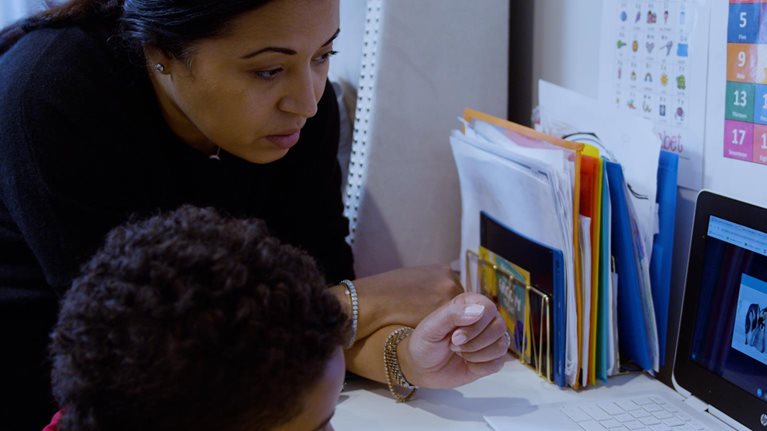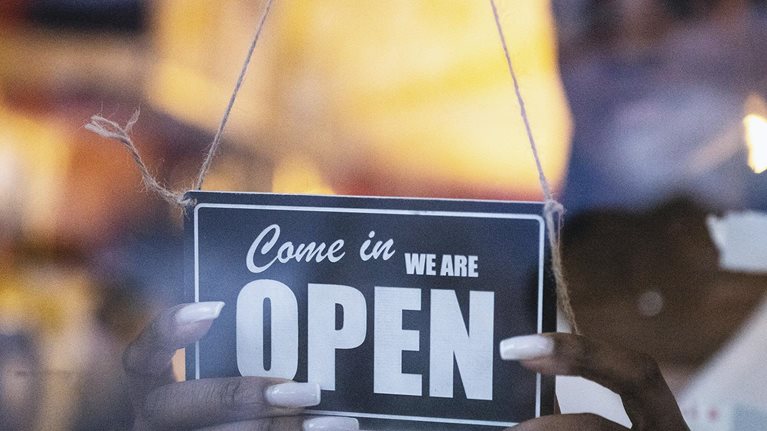After ten years of working to pay for school, LeKisha Finkley was preparing to graduate with an associate’s degree in spring 2020. She earned enough scholarship money to finish her last semester at Southwest Tennessee Community College. She walked the tightrope of bartending while getting a near-4.0 grade point average in her classes. Her plan was to go to Howard University to get her bachelor’s degree in psychology. Then the COVID-19 pandemic hit.
Finkley, 29, lost her job as the number of COVID-19 cases rose across the United States. Her classes moved online, but she was unable to afford internet. She spent her days at fast-food restaurants, using their free Wi-Fi for schoolwork. She soon found herself falling behind. “Even though I was making straight As on everything, I would still go home and lay on my floor and cry,” she said. “It’s like I had talked myself up and said that I was going to graduate. And here I am emailing my professors telling them that I couldn’t do it ... I didn’t have the strength to do it anymore.”
Finkley is one of the many US students whose dreams have been deferred by the COVID-19 crisis. Nationwide, college enrollment dropped by around 560,000 students in fall 2020 compared with fall 2019, according to recent reports from the National Student Clearinghouse Research Center.1 That trend line is even more stark for community colleges—which tend to serve low-income students—and among students of color.2
At Southwest Tennessee Community College, located just outside of downtown Memphis, first-year applications dropped by more than a third compared with 2019. Then there was an 18 percent drop in overall enrollment in spring 2021 compared with fall 2020—a decline nearly double the nationwide average.
Southwest Tennessee Community College’s administrators noticed a particularly sharp decline in the number of Black male students. Half of the Black men enrolled (826 students) dropped out between the spring 2020 and fall 2020 semesters, according to college president Tracy Hall. Colleges across the United States face the same concerning trend: men are dropping out at nearly three times the rate as women are.3
The college formed a task force to find out why the men weren’t returning in the fall. The first concern men cited was the need to take on second jobs during the COVID-19 pandemic. Others didn’t have computers, prompting the college to buy an additional 3,500 laptops to loan to students. Still others had unpaid fees that resulted in holds on their accounts, preventing them from enrolling in classes.
The college also found concerns common to all of their students, regardless of sex, including that many cared for ill parents or children who are now learning virtually from home. “That’s the impact of COVID-19 on our students: life happened to them,” said Hall. “So COVID-19 is just another slap in the face to what they’ve already been experiencing.”
The college received a grant from the US Department of Labor to fund counseling, social services, and career services for unemployed students. It also provided emergency funding for food, housing, transportation, and tuition assistance. Out of the 826 men who left Southwest Tennessee Community College, 72 students were persuaded to return. Many others may never earn their degrees.
“Memphis doesn’t create a lot of opportunities for Black males if they are not credentialed,” said Kendricks Hooker, vice president of academic affairs and creator of the task force. “Providing our students with some of the soft skills that they will need is also important as we provide a path for them to enter into well-paying jobs and enjoy fulfilling careers.”
A widening gap
Last fall, US colleges saw an unprecedented 13 percent drop in first-year enrollment compared with 2019.4 Among students from low-income high schools, enrollment dropped 29 percent for four-year colleges and 37 percent for community colleges, according to the National Student Clearinghouse Research Center.5 The rates of Black, Hispanic, and Native American students returning to college were lower than of white students. The latest spring enrollment figures reveal even further declines, particularly among undergraduates.6
“One of the biggest challenges, I think, is that deferring college for a year is a privileged person’s game,” said Sara Urquidez, executive director of ASP Dallas, a Texas not for profit that provides college counseling primarily for low-income and first-generation high-school students. “You have given students the again-untenable choice: to decide whether they’re going to be a full-time student or they are going to work full-time. And if their family needs them to work full-time, then school is absolutely going to go by the wayside.”
Even if students choose to work in lieu of—or in addition to—school, the pandemic is changing the employment landscape for Americans without college degrees. As of January 2021, the COVID-19 crisis had wiped out millions of low-wage jobs in the United States, predominantly in sectors such as hospitality, education, food services, and manufacturing.7 Since then, there’s been a sharp increase in job openings as the pandemic-related restrictions eased across the United States, particularly in food services and leisure.8 But ongoing job creation will likely be concentrated in high-wage fields (such as healthcare, engineering, mathematics, science, and technology), which typically require employees to have college degrees.
The good news is that some employers are already looking beyond college degrees and at the almost 71 million Americans who may have the skills to thrive but not a degree.9 The pandemic has also spurred further investment to upskill and reskill the workforce. Comprehensive training programs that include job training, counseling, and coaching provided by some private-sector businesses such as Microsoft10 and Google,11 and collaborations like the Rework America Alliance,12 allow workers to develop a more holistic set of skills and can help workers to identify and match talent with job openings at the local level and jumpstart careers. There is also growing support for experienced-based hiring, which can open the door to a more diverse workforce that might otherwise not be considered.
But more can be done. “We need to develop social policy that can buffer these economic forces,” said Martha Ross, a senior fellow of the Metropolitan Policy Program at the Brookings Institution who studies how education affects young workers’ employment prospects and long-term financial earnings. “People with bachelor’s degrees have much, much lower rates of unemployment,” she stated. “[A college degree is] one of the closest things we have to a ticket to the middle class.”
Compared with previous economic downturns, such as the Great Recession of 2008, Ross says this pandemic-related recession is a gut punch to industries that are traditional havens for young workers and workers without degrees. In April 2020, at the peak of the year’s job crisis, US workers without college degrees saw unemployment rates of 19.6 percent, compared with 11.2 percent for those with at least a bachelor’s degree.13 The rates have come down since then, but the gap remains (9.1 percent versus 5.2 percent for those without and with college degrees, respectively).
The employment gap is even more pronounced for Black US workers: those without a college degree had an unemployment rate that was one-third higher than that of white workers without a degree (21.3 percent versus 17.7 percent) at the peak of the pandemic in April 2020.14 Generation Z workers also have been disproportionately affected: those aged from 18 to 24 years experienced a peak unemployment rate of 26.8 percent in April 2020. In January 2021, they experienced an 11.8 percent unemployment rate.15
“Lower-wage workers and younger workers and workers of color are always especially vulnerable,” Ross said. “Younger workers because they have less experience, they have smaller networks, and they’re usually hired more recently than more senior people. But what’s striking here is how laser focused this recession is on very specific industries.”
The restaurant industry is one of them. Anthony Trabasas, 18, had plans to become a chef after he graduated from Food and Finance High School in New York City. In fall 2020, Trabasas, a senior, had secured an internship at a pasta restaurant in Brooklyn, but he lost it when the restaurant closed during the city’s second shutdown in December 2020. “People in the industry are tenacious. But for most people, it’s a hard life. And then especially when you’re seeing what’s currently happening in the food industry,” he said. The cascading closures of New York City’s restaurants led Trabasas to consider building a skill set for a different industry.
When Food and Finance High School’s culinary showcase was canceled in 2020, its students pivoted. They produced Pass the Spatula, a magazine that celebrated chefs of color.16 Trabasas, who leads social media and public relations for the magazine, is carefully considering his choices in light of the slim employment opportunities in the restaurant industry during the pandemic. He has applied to eight to ten local four-year colleges and community colleges, many of them without culinary programs. “Finding a job right now is going to be particularly hard,” he said. “Do I really want to study culinary arts in the future? I find it more strategic to build different skills in, let’s say, business management, marketing, or food science.”
‘Just trying to find a job, like everybody else’
With the current challenging and uncertain employment landscape, it’s even more important for students such as Finkley and Trabasas to consider the various pathways to a fruitful career—including education and skills-building opportunities—as well as to seek access to coaching and professional networks that may not be naturally embedded in their communities. A four-year college degree may still be the best way forward for some. “College is not the dream. College is a pathway to access the dream,” said Stephanie Arias, director of college initiatives at the Cristo Rey Network, a group of 37 high schools that focus on college preparedness for low-income students. “We need a degree to just get our foot in the door. It is not the goal. We don’t ‘make it’ once we have our college degree—it’s just a way to really open up some doors.”
And the importance of opening those doors for people of color is even higher. “I’m frustrated sometimes because we’re not there yet, where we can pretend like Black and brown folks who are first gen and of limited economic means can just not go to college and still have the same level of opportunity,” Arias said.
Betsy Stengel, 26, works at a call center to support herself while attending Bronx Community College. At first, she said, the shift to working from home and taking online classes helped her stay in school while working full-time. But the stress of the COVID-19 pandemic eventually took its toll, as she worried about her mother’s health and the rapidly rising infection rate in the Bronx. “The fact that I didn’t have to physically go to classes, and I was able to schedule them in the evenings or in the super-early mornings ... that helped me in a sense,” she explained. “But then ... people are dying every single day. And I’m hearing it while I’m doing homework.”
Since Stengel moved in with her mother at the beginning of the pandemic, she has been helping support her financially. Her mother stopped working as a homecare health aide for fear of getting infected herself. Stengel said she found herself constantly on edge. Then the call center reduced her hours. “It was just like, am I going to be the next one fired? Are we going to be able to keep up with rent? Can we survive if things go south?”
Finkley, Stengel, and Trabasas represent the complexity of the current challenge for students. They are all young people whose futures are being diverted by the COVID-19 pandemic in varied and nuanced ways.
Stengel enrolled for the spring 2021 semester at Bronx Community College but took on more hours at work to afford the $3,000 tuition. Her increased work schedule has caused her to fall behind in her schoolwork to the point where she says she’ll have to take all her classes over again. “It’s that catch-22, where you’re being pulled to advance in one direction, ultimately retreating in another,” she said via text. For now, she’ll have to defer her dream of graduating until 2022.
Trabasas ultimately won a scholarship competition to the Culinary Arts Institute and plans to earn his associate’s degree in culinary arts before transferring to Cornell University’s School of Hotel Administration. He also has been called back to his restaurant internship and is working on the second issue of Pass the Spatula and an upcoming documentary. “Both projects are focused on the theme of food insecurity, justice, and equity,” he said.
For Finkley, who lost her housing and is staying with the family she babysits for, getting her degree is no longer the priority. She has no plans to finish her last class; instead, she is focusing on enhancing life in her community by starting a not for profit to teach women life skills and provide free meals. “To be honest, we are a generation that desires to change the conditions of these systems that are set up for the wealthy of this country instead of all,” she said. “Whether we have a degree or not, how can we expect to move up in a world where we were always meant to be at the bottom?”


